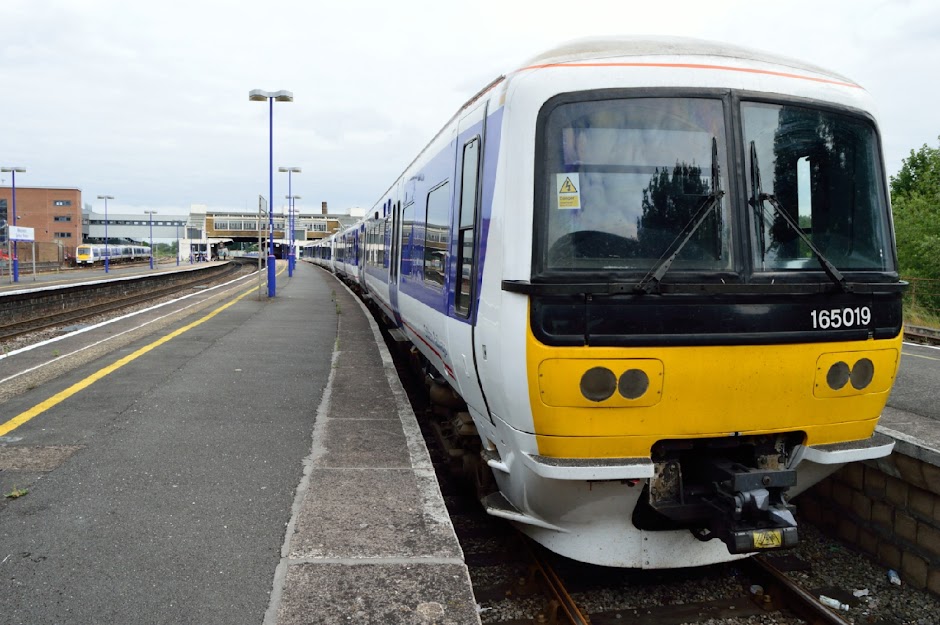 |
| Southern Railway West Country Class Steam Locomotive 34016 'Bodmin' at Alton Photo: Charles Moorhen |
Battle of Britain Locomotive Still Battling
Belonging to a class of UK steam locomotives known as the West Country class, 34016 'Bodmin', seen here in preservation at Alton railway station on the Mid-Hants Railway also known as the 'Watercress Line', is as good today as she was when she hauled an endless succession of trains between London and Cornwall.
'Bodmin'
was one of 110 locomotives, numbered 34001 to 34110, designed by
O.V.Bulleid specifically for hauling passenger trains on the
non-electrified main lines of the Southern Railway.
The
first of the class, 34001 'Exeter', came out of Brighton Works
brand-new in May 1945 where it was allocated to Exmouth Junction shed which opened on the 3rd November 1887 and covered eleven tracks.
Production of the class increased to the point that by November of the following year, 48 locomotives of the West Country class were in traffic. They quickly earned the nickname 'Spam Cans' from the trainspotting community due to the fact that the locomotives were encased in air-smoothing body panels.
Production of the class increased to the point that by November of the following year, 48 locomotives of the West Country class were in traffic. They quickly earned the nickname 'Spam Cans' from the trainspotting community due to the fact that the locomotives were encased in air-smoothing body panels.
At
the beginning, the West Country locomotives were given names
associated with locations in south-west England such as cities, towns
and popular tourist destinations.
In
November 1946 the naming policy was changed. As more locomotives of
the class began to be used around Kent, a decision was made to name a
number of engines after aircraft, airfields, RAF squadrons and key
personalities associated with the WW2 Battle of Britain.
And although identical in every way, a new class of locomotive was born - the Battle of Britain class.
And although identical in every way, a new class of locomotive was born - the Battle of Britain class.
 |
| Detail of Box Pok Wheels and Bodmin Nameplate Photo: Charles Moorhen |
34016 'Bodmin' saw sterling service over the years on Southern rails. On more than one occasion she headed the 'Man of Kent' train between Charing Cross station and Dover Marine station, such as on the 13th September 1958.
In May 1958, West Country Class Pacific Class 34016 'Bodmin', hauled a 'Special' through Kent to London Victoria station. On board was the President of Italy, Signor Gronchi and his wife. He was met at Victoria station by her Majesty Queen Elizabeth II.
Pathe News filmed the arrival and a brief clip of 'Bodmin' can by seen near the beginning.
However, 34016 'Bodmin' was not solely reserved for hauling prestigious 'named trains'. It also saw service heading locals, such as the 4-coach Exeter-Plymouth train on 26th August 1957.
However, 34016 'Bodmin' was not solely reserved for hauling prestigious 'named trains'. It also saw service heading locals, such as the 4-coach Exeter-Plymouth train on 26th August 1957.
On
the 11th April 1958, she was swarmed over by railway enthusiasts at
the annual Eastleigh Works Open Day as she stood resplendent in her
new 'rebuilt' condition which included the removal of her
air-smoothing body panels, leaving her as she appears today.
By June 1964, six years later, after 19 years of service, she had been withdrawn.
With
the last of the West Country/Battle of Britain class, 34110 '66Squadron', emerging new from Brighton Works in January 1951, the
writing was on the wall for steam locomotion.
As
a result, the majority of the West Country, Battle of Britain, and
their sister the Merchant Navy classes, ended their days cut up in
scrap yards.
Luckily,
avoiding one of these scrap yards, 34016 'Bodmin', made the transition
from main line British Railways duties to further duties in
preservation.
In 1952, according to the Ian Allen abc Locoshed Book, 72A loco shed Exmouth Junction was the one to which 34016 was allocated.
At the time of writing (March 2015), 'Bodmin' is out of service and stored at Carnforth.
West Country Class Locomotive Technical Specifications: (British Railways Classification).
Designer: O. V. Bulleid.
Origin: Southern Railway.
Introduced: May 1945.
Purpose: Express Passenger.
Wheel Arrangement: 4-6-2.
Number Series: 34001 - 34110.
Driving Wheel: 6ft. 2in.
Bogie Wheel: 3ft. 1in.
Length: 67ft. 4 3/4 in.
Total Weight: 128 tons 12 cwt.
Water Capacity: 4,500 gallons.
Cylinders: (3) 16 3/8in. x 24in.
Boiler Pressure: 250 lb. sq. in.
Tractive Effort: 31,050 lb.
Coal Capacity: 5 tons.
Power Classification: 7-P 5-F.
Origin: Southern Railway.
Introduced: May 1945.
Purpose: Express Passenger.
Wheel Arrangement: 4-6-2.
Number Series: 34001 - 34110.
Driving Wheel: 6ft. 2in.
Bogie Wheel: 3ft. 1in.
Length: 67ft. 4 3/4 in.
Total Weight: 128 tons 12 cwt.
Water Capacity: 4,500 gallons.
Cylinders: (3) 16 3/8in. x 24in.
Boiler Pressure: 250 lb. sq. in.
Tractive Effort: 31,050 lb.
Coal Capacity: 5 tons.
Power Classification: 7-P 5-F.
Don't forget to subscribe to 'Along These Tracks' railway blog to get all new posts and updates sent directly to you.
Blog update:
Previous photo posts are now easier to find.
All blog posts are now listed alphabetically on the right side of your screen; under the heading, 'Previous Photo Posts'.
"I hope this makes your search easier".
Previous photo posts are now easier to find.
All blog posts are now listed alphabetically on the right side of your screen; under the heading, 'Previous Photo Posts'.
"I hope this makes your search easier".
"Thank You for Visiting"







